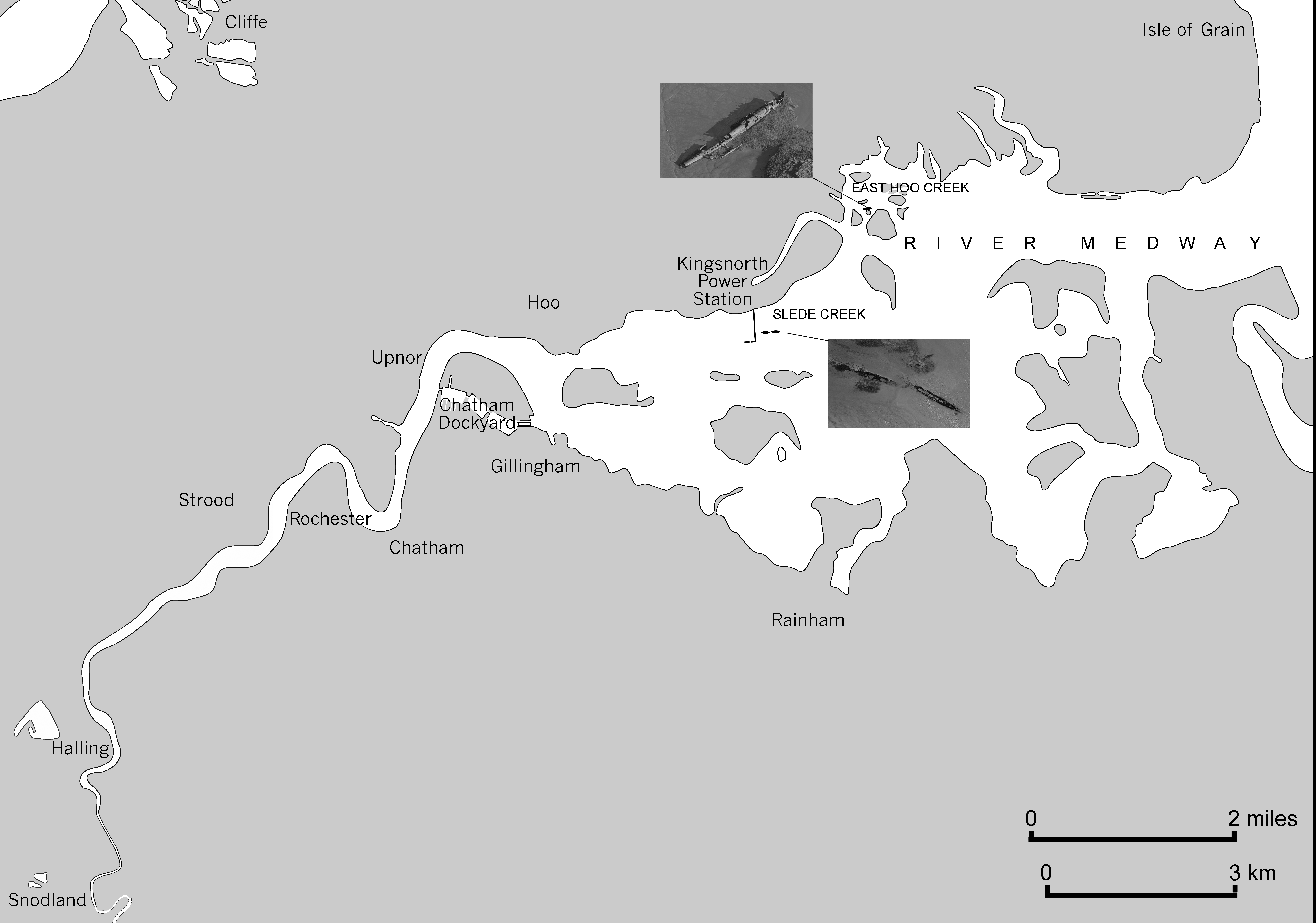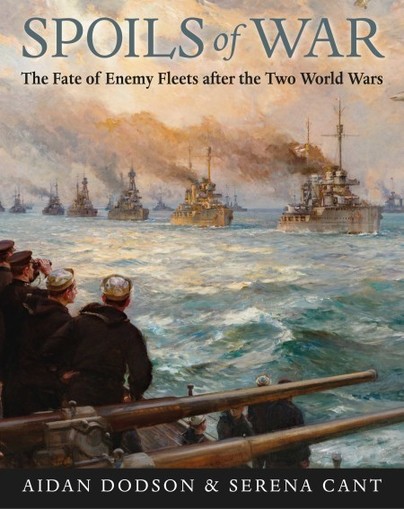Author Guest Post: Aidan Dodson
The Mystery of the Medway U-boats: solved.
Aidan Dodson
University of Bristol
Among the mud-flats of the Medway estuary rest the remains of three First World War German U-boats. One, in East Hoo Creek, still displays some features a submarine, with its raked stem still visible – although broken off and resting at a crazy angle – and its hull structure and ballast tanks visible, the outer plating having largely disappeared. See more here.
The other pair, in Slede Creek, just off Kingsnorth Power Station have, however, been cut down to little more than their bottom frames. The identity of these three boats has long been a matter for speculation, with many ‘solutions’ that are demonstrably impossible. This is certainly the case with the more intact wreck, which most on-line sources currently proclaim that of UB122: this is completely impossible, as we know from official Royal Navy records that this boat was scuttled English Channel half-way between the Isle of Wight and Barfleur in France on 1 Jul 21!
The real identity of the three wrecks as UB144, UB145 and UB150 (although, sadly, not which one is which) has now, however, been established by new archival research contained in my new book, Spoils of War: the Fate of Enemy Fleets after the Two World Wars, written with Serena Cant of Historic England, and due to be published by Seaforth at the end of April. The identity of the Medway U-boats is but one of many ‘myths’ about the fate of ex-enemy vessels after the Wars that are ‘busted’ in this book – quite a few of them surrounding the U-boats handed over following the Armistice that ended the First World War in November 1918.
The terms of that Armistice required that Germany immediately surrender her entire submarine fleet to the Allied and Associated Powers. In this, the U-boat fleet differed from the rest of the German navy: in the case of the surface vessels, a selection were to be interned at Scapa Flow in the Orkneys, and most of the rest laid up in German ports pending the signature of a peace treaty. Only then would many of them be surrendered, to leave Germany with a navy suitable only for coastal defence. However, given how close German submarines had come to forcing the UK into suing for peace during 1917, the absolute surrender of the U-boats was at the top of the Allied agenda. In this connection it is worth remembering that an armistice is only a ‘pause’ in a war, and it remained possible that the First World War could, in theory at least, have resumed at any point prior to the signature of the treaties of peace during 1919/20 – that of Versailles in the case of Germany.
The U-boats were to be assembled in the River Stour, upstream of Harwich, the first vessels arriving on 20 November 1918, and the last on 29 March 1919. The first boats came over under their own power, straight from operations, but the later ones included vessels under repair or not yet complete (sometimes without even engines installed), and had to be towed across. All were formally held in British custody on behalf of the other victorious powers, pending a joint decision on distribution and fates. However, early on, a number were sent on ‘victory tours’ of British ports, while others were sold by the British Admiralty for scrap, with the proceeds to be distributed once proportionate shares had been jointly agreed. In addition, to relieve congestion in the Stour, France agreed in March 1919 to take custody of 26 boats, with 15 more later added – although six were lost in tow from Harwich to Cherbourg, a number ending up on the beaches of England’s south coast. In addition, it was agreed that, pending final agreement, the various Allies should receive a number of U-boats ‘on account’ for trials and other purposes, the UK receiving 22, Italy ten, the USA six, Japan eight and Belgium two (although only one of the latter was sent across – and sank en route).

The long-term fate of ex-German war vessels was the subject of extensive wrangling among the Allies, although eased to a degree when all the best battleships, cruisers and destroyers were scuttled by their crews while interned at Scapa Flow shortly before the Treaty of Versailles was signed in June 1919. Eventually, it was agreed that, while the surrendered German ships and submarines would be shared between the Allies on the basis of proportionate losses, only Italy and France would be allowed to keep a handful in service: everything else had to be scrapped or sunk in deep water within a defined period of time. Thus, the sale for scrap of submarines in British waters, which had been suspended in early 1919, was resumed in the summer of 1920. Some boats nominally now belonged to other nations but, rather than incurring the costs and risk of towing them to their new owners, they were sold ‘as lying’ in British ports, and the proceeds from their scrapping credited to their ‘owner’.
For many years, the key generally-available reference source for details of the fates of the U-boats disposed of after the First World War has been the relevant section of a work by the distinguished German naval historian Erich Gröner (1901–1965) and his associates: Die deutschen Kriegsschiffe, issued in a number of editions over the years, including an English translation in the early 1980s. While most of the facts given by Gröner were correct, there were errors, the most glaring being in the cases where he stated that a given U-boat was ‘run aground’ or ‘sunk’ ‘on the East Coast of Great Britain while en route to being broken up, 1921’. In fact, none of the boats so-tagged were lost in this way, and it seems that this was for some reason adopted as a ‘default’ explanation where Gröner and his team could not find out what had actually happened to a given submarine. The true fate of the boats in question is revealed by British Admiralty records, which state unequivocally that all but one of the boats so-listed were actually scuttled in the English Channel in June 1921, to ensure their destruction prior to the internationally-agreed deadline referred to above. The exception was also sunk in the Channel – as a target in September 1920.
This ‘East Coast error’ has had a direct effect on past attempts at identifying the three Medway wrecks, proposed identifications being generally chosen from this list of boats (including the aforementioned UB122) – or, on occasion, boats listed by Gröner (in most cases – but not all – correctly) as having been broken up at the nearby scrapyards at Rainham and Upnor. Among the latter were U112, UB76, UB93, UB133, UB136, UB144, UB145 and UB150, which were purchased by M. Lynch & Son during July and September 1920, and on arrival seem to have benn moored off Rochester, close to the bridge across the Medway. U112, UB76 and UB93 had been acquired on behalf of Albert Bachelor, owner of the Clinkham Cement Works, of Halling, near Rochester, and the diesel engines of all eight boats were removed for eventual reuse, two at the Halling works, two at the Holborough cement works at Snodland, two at Southend municipal power station, two to provide power for the 1924 Wembley Exhibition, two to a radio transmitter at Daventry 2LO, and two exported to New Zealand. U112 has been a popular identification of the best-preserved Medway wreck, but close examination of the wreck shows it actually to be one of the UB-III type of coastal submarine, not the big MS-type to which U112 belonged. As mentioned above, most on-line sources claim that she is UB122 (one of Gröner’s ‘East Coast errors’), but her wreck is certainly to be found at the bottom of the English Channel.
The true solution to the ‘Medway Mystery’ is actually to be found in a rarely-consulted document in the Ministry of Defence’s Naval Historical Branch at Portsmouth Dockyard. This is the Admiralty’s sales ledger for 1919–39, which lists all the sales for scrap during that period – including all the U-boats sold after the First World War. This gives the exact fates of all vessels in question, in particular highlighting any cases where a vessel was sold, but not actually completely broken up. Thus, we find many here the U-boats which were indeed lost in tow to the breakers, as well as confirmation of the identities of various boats that have subsequently been confused in the literature (including in Gröner’s book) through misreadings, misprints and transpositions of numbers. In particular, non-experts have often failed to realise that U122 and UB122 are completely different submarines, the First World War German navy having three types of submarine: the big U-series, the coastal UB-series and the minelaying UC-series.
Working through the sales ledger, we find the solution to ‘Medway mystery). Among the entries for the boats acquired by M. Lynch & Son we find a note alongside those for for UB144, UB145 and UB150: ‘Hulls dumped 1922’ – something not found for any other U-boats in the ledger). All three were of the UB-III type and thus perfectly match the most intact Medway wreck, and most probably the other pair as well.
There can thus now be little doubt as to the identity of the trio, although working out exactly which boat is which is probably impossible. Identifying submarine wrecks is extremely difficult, as while their class can normally be determined easily, they carried few marks giving their actual names. Propellers were often stamped with a U-boat’s number, but these items are no longer present on the Medway wrecks. Indeed, they may never have had any, UB144, UB145 and UB150 having been launched only a few weeks before the Armistice, and had been towed over to Harwich on 27 March 1919 in the last batch of transfers.
As incomplete vessels, it is likely that they lacked most of the items that made a vessel of real value to a shipbreaker, and thus were not worth selling-on by Lynch & Son, as they did with their other purchases. As also probably demonstrably beyond any hope of use as vessels of war, the Admiralty was presumably persuaded to acquiesce to the hulls of the submarines being dumped on the mudflats after the removal of anything of value, rather than insisting on complete demolition or sinking in deep water, as was their usual practice. The dumped hulks appear to have remained fairly intact until the enhanced demand for scrap metal during the Second World War resulted in two of the wrecks being almost entirely demolished, but leaving the more remote one still looking something like a submarine – to tantalise observers until a forgotten ledger finally revealed the story of the ‘Medway Three’ a century later.

Spoils of War by Aidan Dodson & Serena Cant is available to preorder now from Pen and Sword Books.

